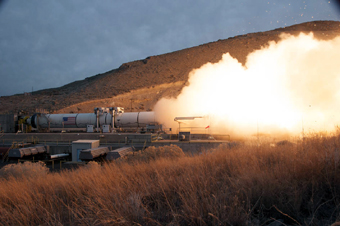
NASA’s 22 Million Horsepower Test
| published March 11, 2015 |
By Thursday Review staff
On Wednesday, NASA tested its largest, most powerful booster engine ever built—an engine designed for the Space Launch System (SLS), the rocket designed to propel the Orion spacecraft into deep space on missions to Mars and Venus in the not-too-distant future.
The new engine will be just one of several interconnected and integrated engine systems with the power to not only break free of Earth’s gravity, but thrust a spacecraft—carrying humans—across our solar system, and possibly beyond.
NASA conducted the two minute test on the ground, in what is called a static test, at the Promontory, Utah facilities of Orbital ATK Propulsion Systems. The 177 foot-long, 25 foot-diameter engine was fired long enough to establish that it could produce the required 22 million horsepower thrust—enough power to lift more than 77 tons into space. Later, after further modifications and after being coupled with other boosters, the entire SLS system is expected to be able to lift 130 metric tons (143 tons) into space.
The booster will be tested again in the near future, and will eventually be transported to NASA’s Kennedy Space Center in Florida.
Related Thursday Review articles:
The View From Above; Thursday Review staff; Thursday Review; March 3, 2015
Orion is Older Than You Think; R. Alan Clanton; Thursday Review; December 9, 2014.
